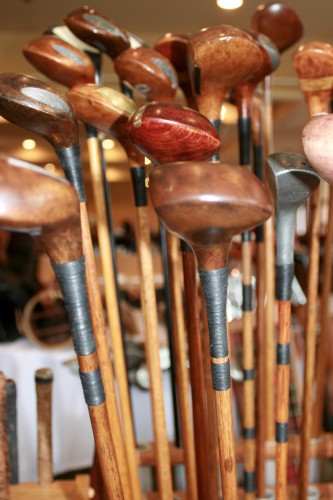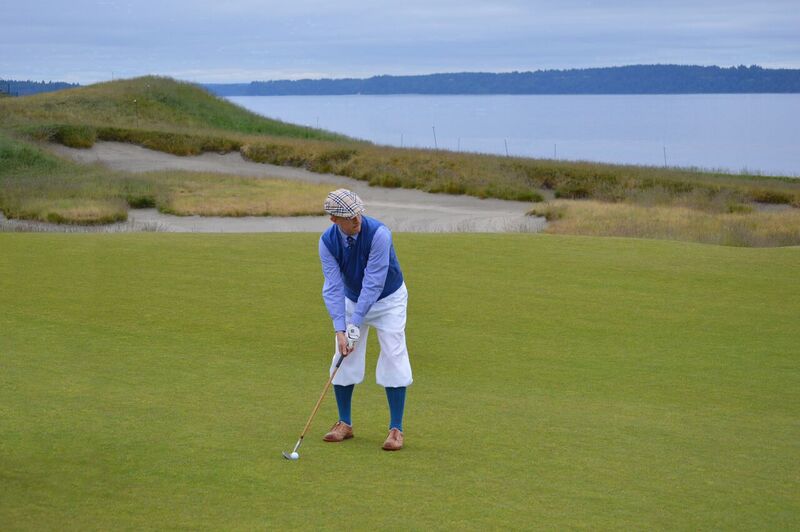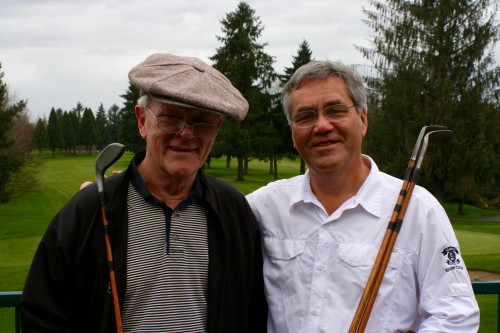Hickory golf: Playing an old game a new way with old clubs
Northwest Hickory Players pay homage to the history of the game
Fascinated by the history of golf, Martin Pool began playing with hickory-shafted clubs, dating from the late 1800s and the early decades of the 1900s, to become personally connected to the game as it was played a century ago.
“What better way to understand the history than to actually live it?” Pool said. And so he would find himself thinking, “this is how Bobby Jones felt playing his niblick out of a bunker,” or imagining what it might have been like for Francis Ouimet or Harry Vardon to swing a mashie on an approach shot.
Rob Birman, a musician and longtime manager of orchestras, remembers being entranced by the sound, the soft tone, the first time he struck a golf ball with a hickory-shafted wood, a sound so different, and so much more pleasing to his ear, than the metallic clang of today’s drivers.
Jim von Lossow, who played on the PGA Tour in 1979 and 1980, worked as a club pro and now runs Vons Golf, a club-fitting/repair business in Seattle, threw together some old hickories for a round with Pool three years ago. He shot 76 and was hooked. Von Lossow plays only hickories now, finding renewed challenge in learning to play an old game in a new way with old clubs.
“It brings so much of the game back to me, the history, the clubs,” he said.
These four golfers, all Washington residents, are core founders and members of the Northwest Hickory Players, which seeks to promote hickory play in the region through various events and tournaments, including the second annual Northwest Hickory Championships, scheduled for May 14-15 at Salem Golf Club and the Oregon Golf Association Course in Woodburn.
“We’re trying to attract members,” he said. “Anybody is welcome to join us and play, and we’ll help them along.”
That includes providing free loaner clubs, when available, to first-time hickory players. Wilson, with an inventory of 70 sets, also provides hickory clubs for rent by larger groups through his Back in the Day Golf business.
Internationally, there’s the Society of Hickory Golfers, which stages the U.S. Hickory Open, scheduled for September in Green Lake, Wis., and there is a long-established hickory golf association through AP National Golf Club, a group of golfers who play at various courses in Washington state. By the way, May 1 has been designated as National Hickory Golf Day, with special events at various courses throughout the nation to promote hickory golf.

A hickory primer:
Hickory players use clubs made in the late 1800s in Scotland and England, as well as clubs manufactured in the United States through 1935. While some clubs are beautiful artwork and relatively costly — Birman plays with a putter inspired by 1912 French Open champion Jean Gassiat, purchased for more than $700 — the golf explosion in the early 1900s resulted in millions of hickory-shafted clubs being manufactured, and they can be found for as little as $10, with better-quality clubs available from $50 to $100.
“You can get in as cheap as you want,” Wilson said. “Once the bug bites you, it starts getting spendy after that.”
Matched sets aren’t the norm with hickory players, who seem to cobble together playing sets with clubs from different makers, and typically play with as few as seven clubs — the number used by Charles “Chick’ Evans Jr. in a stellar amateur career that included winning the U.S. Open and U.S. Amateur in 1916 — and at most 10 or 11.
Replica hickories can be found, too.
“Some people play those,” Pool said. “Personally, I don’t like it. Who wants to play with clubs made yesterday? I want to play with a 100-year-old club and try to break 80. That’s the challenge.”
The challenge is certainly there, as the sweet spot on a century-old club can be minuscule, and higher handicappers might have new appreciation for the advances of modern golf technology after a few swings with a cleek or a mashie, or while trying to escape a bunker with a thin-edged niblick.
“We do get a lot of good players who become interested,” Pool said. “They love the game and they become fascinated by the history and they realize they can play with these. They’re always surprised how well they play. And they get hooked. On the other hand, we have a lot of 20- to 30-handicappers who are dedicated players.”
Certainly, the hickory game is somewhat different — even as gifted a player as von Lossow admits he loses yardage with woods off the tee, and the drop-and-stop wedge game is lacking. So hickory golfers, with their limited club selection, find themselves playing a more links-style game, inventing shots, and thinking the game in a different way.
“I love the idea of shot selection,” Birman said. “When you walk up to the ball you have an infinite number of options.”
When they play their hickories, the golfers embrace the role. They seek older courses, such as Gearhart Golf Links, established in 1892 and site of the Gearhart Hickory Classic, July 16-17. They find old-style bags, and bag stands, and often replica golf balls. They dress the part, too.
“Most of us get into the spirit,” Pool said. “We’ve got the ties on and white shirts. You get 20 of us together and we’re pretty spiffy. That’s what they did back then. It was a classier time.”
Jack Wilson (left) and Martin Pool, key members of Northwest Hickory Players.
Hickory golf resources
For information about the Pacific Northwest Hickory Championships, May 14-15 at Salem Golf Club and the OGA Course in Woodburn, and the Gearhart Hickory Classic, July 16-17 at Gearhart Golf Links, or to learn more about other Northwest events and hickory golf in general, visit the site of the Northwest Hickory Players.
Two excellent sources of information about hickory golf: Washington state’s APNational Hickory Players, , and The Society of Hickory Golfers.
May 1 is National Hickory Golf Day; visit www.nationalhickoryday.com.
For hickory club rental, e-mail Jack Wilson’s Back in the Day Golf, [email protected].
Originally published in the Eugene Register-Guard on April 12, 2016.

